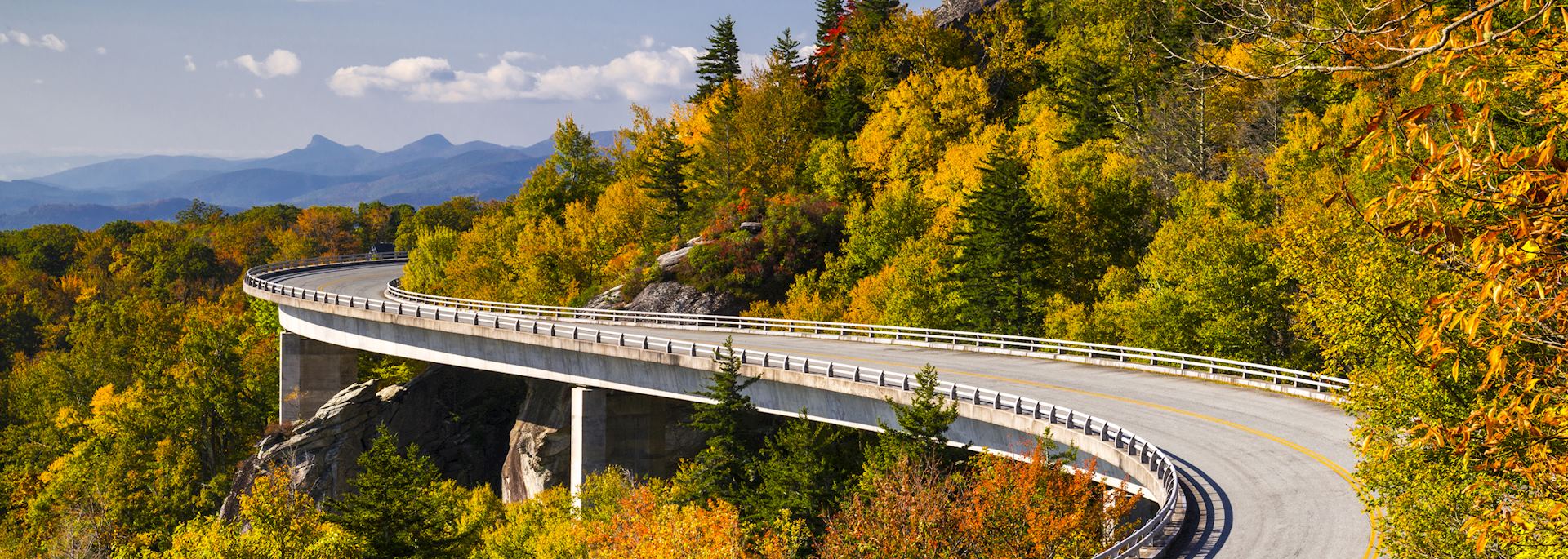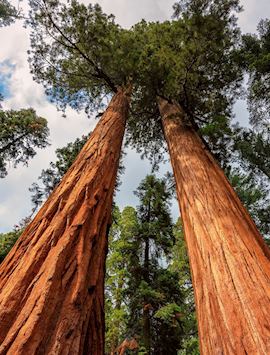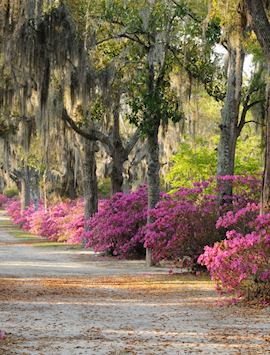By USA specialist David
Intrinsically linking the states of Virginia, North Carolina and Tennessee, a road trip along the Blue Ridge Parkway encompasses Civil War battle sites, huge national parks and towns where you can experience a vibrant music scene.
Explore Shenandoah National Park and take in the blue haze of the parkway from some of the highest points of the Appalachian Mountains, and drive through Great Smoky Mountains National Park, where you can also explore on foot.

Washington, the start of this fly-drive
Washington DC is the logical starting point for anyone driving the Blue Ridge Parkway, although the road itself starts in Front Royal, the north entrance to Shenandoah National Park. It’s the largest international hub in the area and you can quite easily spend a few days here after your flight, exploring many of the capital’s highlights. As the center for US politics, the White House, Pentagon and National Archives — where you can view the Declaration of Independence — are just some of the many sites of interest.

Stopping at Front Royal
Pick up your hire car in Washington DC and drive two hours to Front Royal in Virginia. This small town is just a mile or so from the official starting point of the Blue Ridge Parkway and the surrounding areas include some of the country’s pivotal Civil War battle sites, including Cross Keys and Kernstown. Gettysburg is just two hours north in Pennsylvania, if you want to take a slight detour before joining the Blue Ridge Parkway.

Driving into Shenandoah National Park
The road that snakes its way through Shenandoah National Park is known as Skyline Drive because you are at some of the highest points of the Appalachian Mountains along this part of the route. Surrounded by foliage, you’ll weave your way through the park, where there are plenty of places to stop and admire the views of the densely forested slopes. The blueish haze that the Blue Ridge Parkway is famous for hangs in the air around the poplar, maple, birch and ash trees. This is caused by a vapor emitted by the trees and creates a beautiful soft blue hue that softens the edges of views out across the park.
I’d recommend spending a couple of days exploring Shenandoah. There’s only one hotel in the park, which is government owned and fairly rustic, but the Appalachian Trail walking route runs along the front of the building, making it a worthwhile stop if you’d like to explore the area on foot. If you’re not staying in the park make a stop at the visitors’ center to embark on a circular walk for an hour or so.
Shenandoah is home to an interesting collection of wildlife, from bears, deer and bobcats, to wild turkeys that you’ll often see from the car as they cross the road in front of you.

Driving into Charlottesville
From Shenandoah National Park you will travel across flatter meadows toward Charlottesville. This compact city is the ideal base from which to explore the southern part of the park, should you not want to stay within it.
Charlottesville is dominated by the University of Virginia, one of the top five educational institutions in the USA. Away from the university, the city is pedestrianized, with quaint, boutique shops, an old fashioned cinema and, at the far end of town, a pavilion in which regular live performances are held.
Within a 15-mile radius of the town are the former homes of three US presidents. It’s possible to take tours around these properties, which include Thomas Jefferson’s Monticello — a recognized World Heritage Site — James Madison’s grand mansion, Montpelier, and James Monroe’s timber homestead, Ash Lawn-Highland.

Stopping off in Roanoke
After Charlottesville, the mountains of the northern Appalachian Mountains begin to drop away. This is the mid-way point of the drive, where you’re surrounded by waves of forested hillside.
I’d recommend breaking the journey in Roanoke, as the drive from Charlottesville to Boone — the next logical stopping point — can take eight or nine hours on roads with speed limits of 35 or 40 miles per hour. However, Interstate 81 runs near the Blue Ridge Parkway so, if you want to speed up some of your journey, you can cover some of the distance on this parallel but far less scenic highway.
Though there isn’t an awful lot to do in Roanoke itself, about ten miles away you’ll find the Blue Ridge Music Center. Here you can learn about the musical history of the region, where old-time and bluegrass became popular because of the mixture of migrant workers traveling through the area.

Scenic drive to Blowing Rock and Boone
Nestled in the foothills of the southern Appalachians, just over the border in North Carolina, the towns of Blowing Rock and Boone are a three hour, scenic drive along the parkway from Roanoke. Here, you’re surrounded by rolling hills covered in lush woodland that shelters a variety of wildlife including bears, snakes and bobcats. It’s worth spending a full day exploring the park which is great for outdoor pursuits such as biking, and simple walks around a number of the small lakes that dot the landscape.

Asheville
Leaving the southern Appalachians, your next stop is the city of Asheville. Just 15 minutes off the parkway, this university city has something of a bohemian atmosphere, with the undulating Blue Ridge Mountains as its backdrop.
There’s a strong musical influence in Asheville, which can be heard throughout the many small, locally owned bars. The city, however, doesn’t like to pigeon-hole itself into any one genre. Rather it’s the case that if you can play an instrument you're welcome to get up on stage and perform. I went to one of the many live music venues during my stay, where a violinist was performing. He was soon joined by someone playing the trumpet, then another musician who had a double bass. You never really know what you’re going to hear (which is part of the appeal) and the type of music you’ll listen to will vary from one bar to another.
I’d recommend spending three nights in Asheville as there’s plenty to see and do in the area. Part of the city is taken up by the Biltmore estate, constructed by George Vanderbilt in the 1800s for his mother, who, it was rumored, didn’t have long left to live. She did, in fact, live for another 25 years or so.
This grand property sits in about three and a half acres of land with views over the northern tip of Great Smoky Mountains National Park, and I’d allow a couple of hours to explore under your own steam. The first room of the château-style house, with its palm trees and glass roof, is reminiscent of a greenhouse, the exotic plants that grow here an indication of the wealth of the household.
A winery was also established on the estate and this is still producing wine. As part of your visit you can enjoy complimentary wine tasting in Ampler village, an area used to accommodate the Vanderbilt’s more favored servants, which is a ten-minute shuttle ride from the house.
At the bottom of the estate lies Biltmore village. Vanderbilt wanted his servants to have the best quality of life possible and built this village for them. By setting up a community at the entrance to the estate, within easy walking distance to work, he created an area his servants could call their own, and in turn was rewarded with their loyalty. The area has now been revamped into a smart shopping area.
Don’t miss the opportunity to sample some local dishes in a city well-known for its barbecues. 12 Bones Smokehouse, which serves up sticky ribs, is a personal favorite, and has played host to Barack Obama twice. It’s very much a spit and sawdust venue, where I was introduced to grits, a dish made of ground corn similar to porridge or polenta, and eaten with a variety of flavorings such as blue cheese.

Driving through Great Smoky Mountains to Cherokee
From Asheville, head toward the Great Smoky Mountains to witness a thick vapor hanging in the air like smoke signals. This fog-like mist is emitted by the surrounding trees, and is, unsurprisingly, what gives the park its name. The Native American town of Cherokee, where the Blue Ridge Parkway ends, sits at the entrance to the park and is a great base from which to explore.
Great Smoky Mountains is America’s most visited national park and there are plenty of ways to fill your time here. Embark on one of the many walking trails, cross Mile High Swinging Bridge, the country’s highest suspension footbridge, to reach the peak of Grandfather Mountain for panoramic views of your misty surroundings.
Practicalities
Things to consider when driving along the Blue Ridge Parkway
- This route is 470 miles long, and it’s worth taking two weeks to allow enough time to comfortably explore the various highlights along the way.
- An intermediate 4x4 is a good choice of vehicle, as it’s more suitable for some of the steeper inclines within the national parks.
- The best time to drive along the Blue Ridge Parkway is from mid-May to mid-September.
- The speed limit along the Blue Ridge Parkway is 25 to 45 miles per hour, so relax and take your time.
Plan your self-drive along the Blue Ridge Parkway
Start thinking about your experience. These itineraries are simply suggestions for how you could enjoy some of the same experiences as our specialists. They're just for inspiration, because your trip will be created around your particular tastes.
View All Tours in The US


